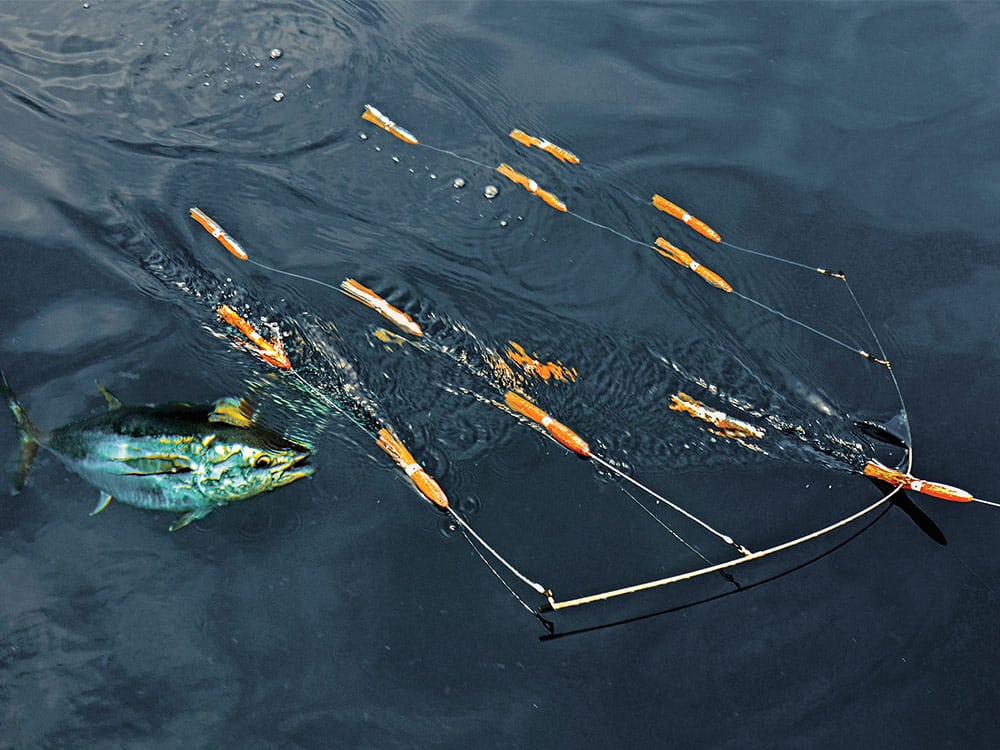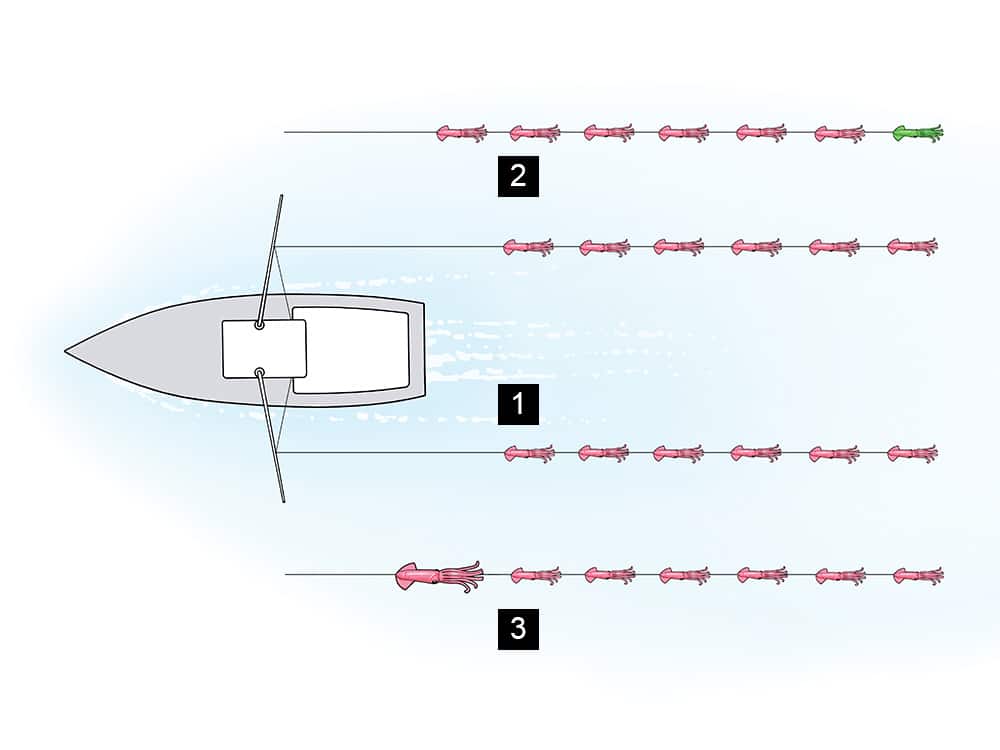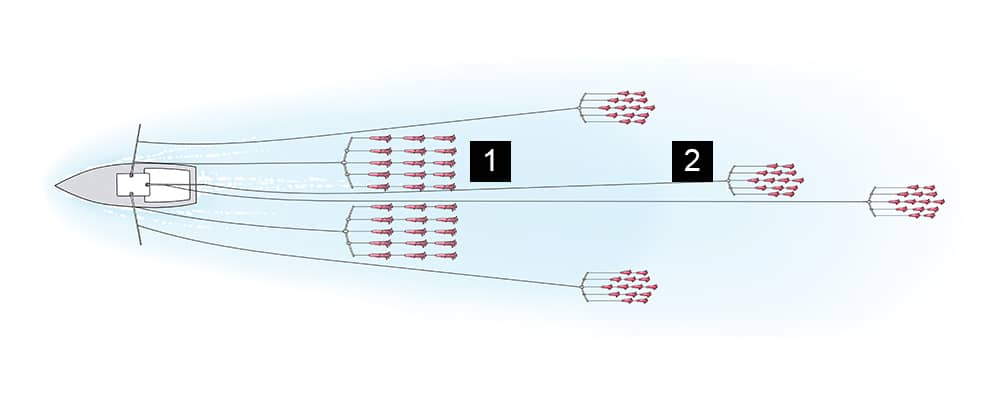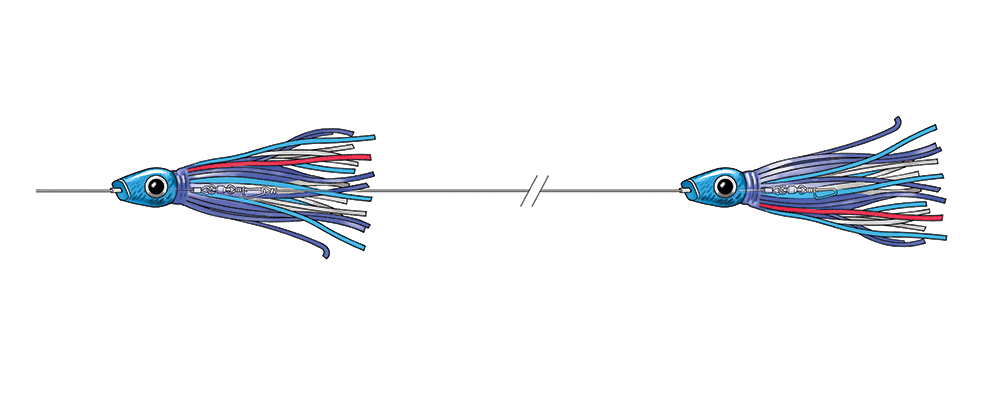Offshore teasers are designed to attract big game to the boat, where anglers pitch-bait or tease them onto a flat-line bait. If the fish fades back, there’s a chance of it striking one of the baits staggered farther back, but that’s just one reason for setting up teasers to bring the show up close.

Teasers create the illusion of action behind the boat in the prop wash, such as a feeding frenzy. Fish holding deep or hunting in the upper part of the water column sense the boat and lock in on the prop wash and your strategically placed teasers.
The rule-of-thumb starting point for teasers and daisy chains is to place them in clean water just outside the prop wash, about 25 feet back, pulled off the teaser lines on the outriggers, and tweak from there as the situation demands.
The water behind the boat is your canvas, and teasers are your paint and brushes. The game fish grade your artistry. Below, these 11 teaser configurations excel at raising more sailfish, white, blue and striped marlin, tuna and dolphin.
Three Squid Daisy Chain Teaser Configurations

2.) Weakest-link configuration
3.) Alpha squid setup Illustration by Steve Sanford
The standard squid daisy chain is a mainstay when trolling for sailfish and white marlin, and works like a Pied Piper for holding school dolphin near the boat. We’ve plucked dolphin one right after another by pitching lures and cut baits behind this teaser.
Deploy daisy chains off teaser rings on the outriggers, and line them up to run 20 to 30 feet behind the boat, in the clean water outside the prop wash. (first teaser) Versions of the squid daisy chain range from traditional in-line models to dual-dimensional ones that swim as well as flop. “Many of the top pro boats still use traditional pink or green squid,” says Frank Johnson III of Mold Craft Lures. “The trend is toward more colors. We offer countless colors for our squid and lures, but sometimes it’s not necessary to reinvent the wheel.
“I’ve always been a proponent of adding a different color squid at the end of the chain (second teaser) — the weak-link illusion, if you will,” he says. “Some pros add a larger lead squid, like our 18-incher, to our 9-inch squid chain (third teaser). This holds the nose of the chain down when they’re trolled short and from a high angle. It creates more commotion too.”
Another Take on the Squid Daisy Chain

John Oughton, a hardcore Ocean City, Maryland, white marlin captain, swears by Mold Craft squid daisy chains. “I add a blue-and-white Ilander Express to the end of the teaser, with a ballyhoo or strip bait tight to it, hookless, of course,” he says. “It’s our top surface teaser for white marlin. My next productive surface teaser is a daisy chain of blue-and-white Ilanders. My secret squid color? Pink, hands down.”
Bad Ass Teaser (BAT)

The Bad Ass Teaser (BAT) consists of five 13-inch black mudflaps cut to resemble bonito and tuna, with an Ilander Express at the end. The tuna silhouettes create a slapping disturbance, trailed by a smoking lure. “They’re set 20 to 30 feet back in clean water,” says Harry Vernon III of Captain Harry’s Fishing Supply in Miami. “Marlin eat tuna and bonito, and this teaser does an incredible job at depicting them at the surface. One trick in fishing these teasers is to add a hookless horse ballyhoo or mullet to the Ilander Express in the back.”
Squid Spreader Bars

2.) Two spreader bars trolled on small- to mid-sized boats 10 and 20 feet behind the boat. Illustration by Steve Sanford
Marcel Israel out of Shinnecock Inlet on Long Island, New York, fabricates his spread around squid spreader bars when searching for yellowfins, bigeyes and albacore, with hook baits positioned around each gang of squid.
“In the canyons, I pull two spreader bars, each with 14 13-inch squids,” he says. “These run 80 feet back, in the middle. I set at least four bars — either 40-inch spans with 12 9-inch squids, or 48-inch spans with 15 9-inch squids — farther back to the outside, in the center, behind the spread. I use three center riggers to place these spreader bars down the middle.”
On small and midsize boats, they’re simply trolled as a pair, one off each outrigger, between 10 and 20 feet behind the boat.
Daisy Chains with a Hookless Chase Bait

Off Southern California, Greg Stotesbury favors chains with a hookless chase bait for striped marlin. “We run Mold Craft 9-inch squid off each corner,” he says. “Six or eight pink or red squids, 12 inches apart, chased by a black-and-purple Senior Wide Range Softhead with a hookless ballyhoo.”
David Brackmann of Caliente in Cabo San Lucas tweaks it a bit: “We pull five or six 9-inch squids in pink, blue or green on 3-inch droppers, with a Wide Range Mold Craft or blue-and-white Ilander with a hookless horse ballyhoo.”
Three Bird Teasers

2.) 10-foot leader with feather
3.) Bird Daisy chain Illustration by Steve Sanford
Dave Workman Jr. of Strike-Zone Tackle in Jacksonville, Florida, ranks the bird among the best teasers. “They create the illusion of a feeding frenzy,” says Workman. “Then about 20 feet behind that splashing, there’s a lure or bait with a hook, which is what the fish end up striking. Birds need weight at the tail to lift their heads and maximize action, and that’s where the trailing bait or lure comes in. I like a 20-foot leader between the bird and bait (first rig).”
Workman says a 7-inch Boone Bird with a 10-foot leader and a Clarkspoon or feather is deadly for mackerel (second rig). Blackfins, yellowfins and dolphin respond well to lures and baits behind birds. He often deploys chains of five birds rigged on 10 to 15 feet of 300-pound mono (third rig).
Double Hookless Lures

Large hookless lures, such as the Bost Blackhead Big Game Teaser, are still in vogue as marlin teasers. A modern twist includes rigging them tandem, 24 to 30 inches apart. Their sheer size enhances their action, heightened when two teasers fight each other. Single and tandem surface teasers are also small-boat friendly. Aside from their typical placements tight to the boat, color becomes a factor. If there’s an abundance of bonito or tuna, opt for purple or black teasers. If dolphin are running, select green-yellow patterns.









